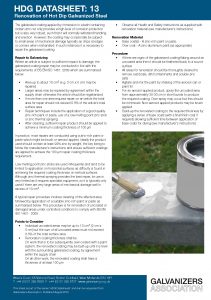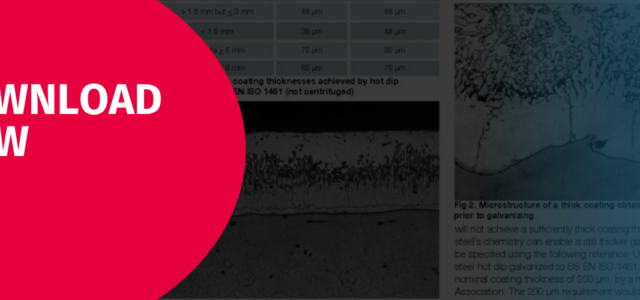Renovation of Hot Dip Galvanized Steel
The galvanized coating applied by immersion in a bath containing molten zinc not only provides a high level of corrosion protection but is also very robust, such that it will normally withstand handling and erection.
 However, the coating may occasionally be subject to small areas of mechanical damage typically as chips at edges or corners when mishandled. In such instances it is necessary to repair the galvanized coating.
However, the coating may occasionally be subject to small areas of mechanical damage typically as chips at edges or corners when mishandled. In such instances it is necessary to repair the galvanized coating.
Galvanized coating repair
Where an article is subject to sufficient impact to damage, the galvanized coating repair may be conducted in line with the requirements of BS EN ISO 1461: 2009 which are summarised in the datasheet.
This datasheet contains information on the following:
- BS EN ISO 1461: 2009 requirements for galvanized coating repairs
- individual uncoated areas and the sum of uncoated areas
- renovation coating thickness
- renovation material for galvanized steel
- the procedure
Want to have a pdf version of this datasheet? Click the button below.
In practice, most coating repairs are conducted using a zinc-rich paint or paste which might be brush or aerosol applied. Ideally the product used should contain at least 90% zinc by weight, the key being to follow the manufacturer’s instructions and ensure sufficient coatings are applied to achieve the 100 µm repair coating thickness requirement.
Low melting point zinc sticks are used infrequently and tend to be limited to application on horizontal surfaces as difficulty is found in achieving the required coating thickness on vertical surfaces. Although zinc thermal spraying provides the best coating repair, its use is very limited as it requires specialist equipment, so it is typically only used if there are very large areas of mechanical damage well in excess of 10 cm2.
A typical repair procedure involves cleaning of the affected area followed by application of a suitable zinc-rich paint or paste as summarised below. This procedure is for renovation of uncoated or damaged areas under controlled conditions to comply with BS EN ISO 1461 : 2009.

